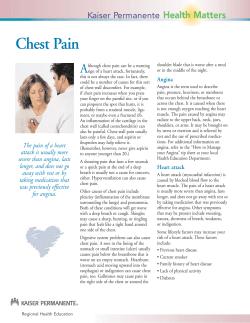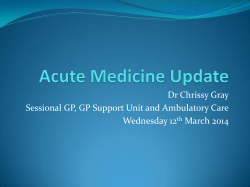
To Bridge or Not to Bridge Periop Anticoagulation Management Don Weinshenker, MD
To Bridge or Not to Bridge Periop Anticoagulation Management Don Weinshenker, MD Ambulatory Care Denver VAMC Financial Disclosure Information Nothing to report Periop AC Management Chronically anti-coagulated patient + procedure Bridge with heparin or not bridge with heparin? Periop AC Management On what are our guidelines based? • Observational data • No randomized controlled trials • Expert opinions Therefore: • We need to individualize therapy. • We need to use our judgment. • We need to take into account guidelines. Resources ACCP Guidelines: Perioperative Management of Antithrombotic Therapy http://www.chestjournal.org/content/133/6_suppl/299S.abstract?etoc Chest June 2008 133;6:299S-339S ACC/AHA Guidelines: Management of Patients with Valvular Heart Disease (2008 update) http://content.onlinejacc.org/cgi/reprint/52/13/e1 J. Am. Coll. Cardiol., September 23, 2008; 52: e1 - e142. Indications to Chronically Anticoagulate • Mechanical Heart Valves • Atrial Fibrillation • Thromboembolic disease (DVT/PE) Case 1 Patient with mechanical heart valve who will be undergoing a procedure. 1. 2. 3. 4. 5. Proceed directly to surgery. Hold warfarin for 5 days and no bridge. Bridge with IV unfractionated heparin (UFH). Bridge with LMWH. Need more information. Periop Bridging Anticoagulation First Question: Do you need to stop the anticoagulation therapy for this procedure? Periop Bridging Anticoagulation Don’t necessarily need to stop AC for all procedures: • • • • • Cataracts Dermatology procedures Dental procedures Diagnostic endoscopies (?) Arthrocentesis (?) 1 Need to balance risk of bleeding with risk of clot. If in doubt, ask the person doing the procedure. 1 Arthritis Rheum. 1998; 41:736-739 Case 1 (modified) Patient with bi-leaflet aortic mechanical valve who will be undergoing an open AAA repair. 1. 2. 3. 4. 5. Proceed directly to surgery. Hold warfarin for 5 days and no bridge. Bridge with UFH. Bridge with LMWH. Need more information. Case 1 (modified) Patient with bi-leaflet aortic mechanical valve who will be undergoing an open AAA repair. 1. Bleeding risk of procedure? High risk of bleeding so need to stop warfarin. 2. Risk of clot? Need to assess the risk of the valve. Rule of Thumb Assuming high risk of bleeding from procedure so will need to stop warfarin: High risk of clot: Bridge with therapeutic dose of heparin. Intermediate risk of clot: Bridge with therapeutic dose of heparin. Bridge with low intensity heparin? Low risk of clot: No bridge or low intensity heparin. Chest 2008 133;6:299S-339S Mechanical Heart Valves Caged Ball (Starr-Edwards) Tilting Disc (Bjork-Shiley) Bi-leaflet (St Jude) Mechanical Heart Valves Eckman JAMA 1990;263:1513 Mechanical Heart Valves High risk for arterial thromboembolism: 1. 2. 3. 4. Mitral valve prosthesis Older generation AoVR (ball in cage, tilting disc) Recent CVA/TIA (within 6 months) Multiple mechanical valves. Moderate risk for arterial thromboembolism: 1. Atrial fibrillation 2. Prior CVA/TIA 3. Other risk factors (HTN, CHF, DM, age >75) Low risk for arterial thromboembolism: 1. Bileaflet AoVR without other risk factors. Chest June 2008 133;6:305S Mechanical Heart Valves Chest June 2008 133;6:305S Mayo experience (MHV) Study: • Looked at 556 MHV patients who underwent 580 procedures. • Majority of valves were bi-leaflet valves. • Followed for three months post op. • 375 patients with single MHV in aortic position. Results • Overall risk of clot is low: 0.9% after three months. • No patient developed prosthetic valve thrombosis. • 25% of pts with single AoVR did not receive any heparin. • None of these 25% developed any thromboembolism. Daniels PR. Et al., Thromb. Res. (2009), doi:10.1016/j.thromres.2009.01.011 Mechanical Heart Valves ACCP: 1. High Risk: Recommend therapeutic-dose heparin. 2. Intermediate Risk: Recommend therapeutic-dose heparin. 3. Low Risk: Recommend no bridging or low-dose heparin. Chest 2008 133;6:299S-339S ACC/AHA: 1. High Risk: Recommend therapeutic-dose heparin. 2. Intermediate Risk: not addressed. 3. Low Risk: “Heparin is usually unnecessary.” J Am Coll Cardiol. 2008 52:e1 Case 1 (modified again) Patient with bi-leaflet aortic mechanical valve in 76 yo patient with HTN and DM who will be undergoing an open AAA repair. 1. 2. 3. 4. 5. Proceed directly to surgery. Hold warfarin for 5 days and no bridge. Bridge with UFH. Bridge with LMWH. Need more information. UFH vs LMWH LWMH advantages: • LMWH is considered to be “safe” for bridging but has not been studied head to head with UFH. 2. LMWH is cheaper than UFH assuming LMWH is given on an outpatient basis vs inpatient with UFH.1 However: 1. Bridging or even anticoagulating patients with mechanical heart valves with LMWH is not a labeled indication. 2. ACC/AHA recommends UFH over LMWH while ACCP recommends LMHW over UFH. 1 Chest May 2004; 125:1642-1650 Bridging with LWMH PRE-OP: 1. 2. 3. Start holding warfarin 5 (to 6) days ahead of time. Start LMWH when INR is < 2.0. Last dose of LMWH: 50% dose 24 hours ahead POST-OP: Start warfarin day after surgery (or later depending on surgery). Low Bleeding Risk - Restart therapeutic dose LMWH 24 hours post op High Bleeding Risk: - Restart LMWH 48-72 hours post op - Consider low dose LMWH - Consider no LMWH at all. Chest 2008 133;6:299S-339S Mechanical Heart Valves Bottom Line: Bridge all patients with mechanical heart valves with the exception of those with isolated bi-leaflet aortic valves and no risk factors. Generally recommend LMWH for bridging if you do decide to bridge. Have to take into account post op bleeding risk and adjust post op heparin accordingly. Case 2 62 yo patient, status past TIA 2 years ago, with chronic non-valvular atrial fibrillation. No history of CHF, HTN, or DM. Chronically anticoagulated with warfarin. Is going to undergo radical prostatectomy. 1. 2. 3. 4. 5. Proceed directly to surgery. Hold warfarin and no bridge with heparin. Bridge with UFH. Bridge with LMWH. Need more information. Atrial Fibrillation CHADS2 Score (nonvalvular afib): CHF (1 pt) HTN (1 pt) Age > 75 (1 pt) DM (1 pt) Stroke, TIA or systemic TE event (2 pts) JAMA 2001; 285: 2864 Atrial Fibrillation JAMA 2001; 285: 2864 Atrial Fibrillation CHADS2 Score: CHADS2 : C: CHF (1 pt) H: HTN (1 pt) A: Age > 75 (1 pt) D: DM (1 pt) S: Stroke, TIA or TE event (2 pts) Total Score: Case 2 Patient: 0 pt 0 pt 0 pt 0 pt 2 pts 2 pts Atrial Fibrillation Our patient’s score is 2. What do we do? First, let’s look at who should be anticoagulated long term: ACC/AHA (2006) CHADS2 Score: 0 1 2 or higher Recommended AC: Usually asa alone. asa* oral anticoagulation *Exceptions to score of 1: Rec AC if reason score is 1: age 75 or older, or 65 and older and CHF, or EF < 35%, or 65 to 74 with DM or CAD Circulation August 15, 2006:e292 Mayo experience (afib) Mayo Clin Proc June 2008;83(6):639-645 Atrial Fibrillation Our patient’s score is 2 due to stroke. What do we do? 1. CHADS2: 0-1 > or = 2 ACCP: No bridge or bridge with low dose LWMH Rec bridging with therapeutic dose LMWH Chest 2008 133;6:299S-339S 2. CHADS2: 0-3 > or = 4 Mayo: No bridge except would bridge if hx/o stroke Rec bridging (usually with therapeutic dose LMWH) Mayo Clin Proc June 2008;83(6):639-645 3. ACC/AHA “High Risk” (hx/o stroke/TE): Rec bridging with heparin Otherwise, “AC may be interrupted for up to a week without substituting heparin.” Circulation August 15, 2006: e298 Case 3 70 yo man with history of unprovoked DVT 9 months ago on warfarin. No history of thrombophilic conditions, no cancer. Undergoing prostatectomy. 1. 2. 3. 4. 5. Proceed directly to surgery. Hold warfarin and no bridge with heparin. Bridge with UFH. Bridge with LMWH. Need more information. Venous Thromboembolism Some differences between patients with VTE and afib/mechanical heart valves (MHVs): Afib/MHV: Risk of arterial TE/Stroke: If occurs, high risk of neurological compromise/death (70%) Chest 2008 133;6:299S-339S Kaplan Neurology 2005; 56:368-375 Longstreth Neurology 2001; 65:835-842 Venous TE: Risk of recurrent venous TE (DVT/PE): Fatal in 4-9% and less morbidity Chest 2008 133;6:299S-339S Douketis Ann Intern Med 2007: 147:766-774 Douketis JAMA 1998; 279:458-462 Venous Thromboembolism Some differences between patients with VTE and afib/mechanical heart valves (MHVs): Afib/MHV: Low dose heparin has not been well studied and hasn’t been proven to decrease arterial TE. Chest 2008 133;6:299S-339S Venous TE: Low dose heparin has been shown to decrease post-op DVTs (non-bridging trials). Perhaps consider more strongly in intermediate risk patients compared with afib/MHV. Chest 2008 133;6:299S-339S Geerts Chest 2004; 126 (suppl):338S-400S Venous Thromboembolism Chest June 2008 133;6:305S Case 3 70 yo man with history of unprovoked DVT 9 months ago on warfarin. No history of thrombophilic conditions, no cancer. Undergoing prostatectomy. Risk: Intermediate Bridging? Perhaps low dose heparin? Rule of Thumb Assuming high risk of bleeding from procedure so will need to stop warfarin: High risk of clot: Bridge with therapeutic dose of heparin. Intermediate risk of clot: Bridge with therapeutic dose of heparin. Bridge with low intensity heparin? Low risk of clot: No bridge or low intensity heparin. Chest 2008 133;6:299S-339S Questions? Discussion? ACCP Risk Assessment Chest June 2008 133;6:305S ACCP Recommendations Chest June 2008 133;6:313S
© Copyright 2025





















